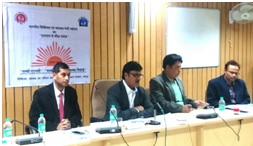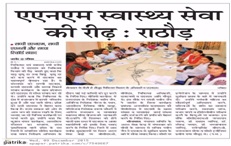Concept of NRHM
The National Rural Health Mission (NRHM) is a National effort at ensuring effective healthcare through a range of interventions at individual, household, community, and most critically at the health system levels. Despite considerable gains in health status over the past few decades in terms of increased life expectancy, reductions in mortality and morbidity serious challenges still remain. These challenges vary significantly from state to state and even within states.
There has been a progressive decline in budgetary allocation for public health in the country from 1.3% of GDP in 1990 to 0.9% in 1999. Rising inequities are another area of concern. Studies demonstrate that curative services favour the rich over the poor. Only one tenth of the population is covered by any form of health insurance thereby exposing the large majority to the risk of indebtedness in the event of a major illness in the family. Operational integration in policy and programme between various vertical programmes within the health sector, and between health and other related sectors such as drinking water, sanitation, and nutrition has been limited, resulting in a lack of holistic approaches to health. A number of States particularly in North, East and North Eastern parts of the country have stagnant health indicators and continue to grapple with significant morbidity and mortality. The causes for this basically lie in socio-economic factors, under performing health systems and weak institutional framework.
The National Common Minimum Programmer spells out the commitment of the Government to enhance Budgetary Outlays for Public Health and to improve the capacity of the health system to absorb the increased outlay so as to bring all round improvement in public health services. This Mission seeks to provide effective health care to the rural population, especially the disadvantaged groups including women and children, by improving access, enabling community ownership and demand for services, strengthening public health systems for efficient service delivery, enhancing equity and accountability and promoting decentralization.
Key Components & Strategies
The NRHM provides broad operational framework for the Health Sector. Suggestive guidelines have been issued on key interventions like ASHA, Indian Public Health Standards (IPHS), institutional deliveries, immunization, preparation of District Action Plan, role of Panchayati Raj Institutions etc. The States shall have flexibility to project operational modalities in their State Action Plans, which would be decided in consultation with the Mission Steering Group.
Core strategies of NRHM include:Increasing Community ownership by vesting responsibility with PRIsDecentralized village and district level health planning and managementAppointment of Accredited Social Health Activist (ASHA) to facilitate access to health servicesStrengthening the public health service delivery infrastructure, particularly at village, primary and
secondary levels,Mainstreaming AYUSH,Improved management capacity to organize health systems and services in public healthEmphasizing evidence based planning and implementation through improved capacity and infrastructure,Promoting the non-profit sector to increase social participation and community empowerment, promoting healthy behaviors, and improving intersectional convergence.
Supplementary StrategiesRegulation of the private sector to improve equity and reduce out of pocket expensesFoster public–private partnerships to meet national public health goals,Re-orienting medical education,Introduction of effective risk pooling mechanisms and social insurance to raise the health security of the poor,Taking full advantage of local health traditions.
Goals of NRHM and Mission OutcomesThe goals of NRHM are outlined below:Reduction in Infant Mortality Rate and Maternal Mortality Ratio by at least 50% from existing levels in next seven yearsUniversalize access to public health services for Women’s health, Child health, water, hygiene, sanitation and nutritionPrevention and control of communicable and non-communicable diseases, including locally endemic diseasesAccess to integrated comprehensive primary healthcareEnsuring population stabilization, gender and demographic balance.Revitalize local health traditions and mainstream AYUSHPromotion of healthy life styles.The Mission outcomes are expected to follow a phased approach and are at two levels:
1. National Level
Infant Mortality Rate to be reduced to 30/1000 live births
Maternal Mortality Ratio to be reduced to 100/100,000
Total Fertility Rate to be brought to 2.1
Malaria mortality reduction rate –50% upto 2010, additional 10% by 2012
Kala Azar to be eliminated by 2010.
Filaria/Microfilaria reduction rate: 70% by 2010, 80% by 2012 and elimination by 2015
Dengue mortality reduction rate: 50% by 2010 and sustaining at that level until 2012
Japanese Encephalitis mortality reduction rate: 50% by 2010 and sustaining at that level until 2012
Cataract Operation: increasing to 46 lakhs per year until 2012.
Leprosy prevalence rate: to be brought to less than 1/10,000.
Tuberculosis DOTS services: from the current rate of 1.8/10,00, 85% cure rate to be maintained through the entire Mission period.
2000 Community Health Centers to be upgraded to Indian Public Health Standards
Utilization of First Referral Units to be increased from less than 20% to 75%
250,000 women to be engaged in 18 states as Accredited Social Health Activists (ASHA).
2. Community Level
Availability of trained community level worker at village level, with a drug kit for generic ailments
Health Day at Anganwadi level on a fixed day/month for provision of immunization, ante/post natal checkups and services related to mother & child healthcare, including nutrition
Availability of generic drugs for common ailments at Sub-centre and hospital level
Good hospital care through assured availability of doctors, drugs and quality services at PHC/CHC level
Improved access to Universal Immunization through induction of Auto Disabled Syringes, alternate vaccine delivery and improved mobilization services under the programme
Improved facilities for institutional delivery through provision of referral, transport, escort and improved hospital care subsidized under the Janani Suraksha Yojana (JSY) for the Below Poverty Line families
Availability of assured healthcare at reduced financial risk through pilots of Community Health Insurance under the Mission
Provision of household toilets
Improved Outreach services through mobile medical unit at district-level.



